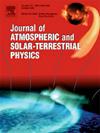On the strength of E and F region irregularities for GNSS scintillation in the dayside polar ionosphere
Abstract
We present results of the study conducted to quantify the relative contribution of different ionospheric regions to phase scintillation in Global Navigation Satellite Systems (GNSS) at the dayside high latitude ionosphere. By taking advantage of the scanning capability of the 32-m EISCAT radar in Svalbard (ESR) and its recurrent favourable location below the dayside auroral region, we developed a methodology to identify conjunctions between the radar and GNSS satellite signals in order to compare density irregularities identified by the radar with scintillation observed in GNSS signals. The analysis revealed that the dayside ionosphere contained irregularities predominantly in the F region with scintillation occurring 77% of the times. The likelihood of observing irregularities in the E region were comparatively less with a scintillation occurrence rate of 42%. The study therefore strongly suggests that the dayside F region is more structured than the E region and is the predominant source region for irregularities that cause scintillation at GNSS frequencies. The associated ionospheric conditions revealed enhanced F region electron and ion temperatures to be collocated with scintillation for majority of the times. This supports the fact that cusp/auroral dynamics play a crucial role in creating F region irregularities which can act as sources of scintillation in GNSS signals. The presented results provide a quantitative estimate of the effectiveness of irregularities and the associated ionospheric conditions in different regions of the dayside ionosphere during scintillation, which are relevant for high latitude modelling and instability studies as well as for space weather applications.

| 公司名称 | 产品信息 | 采购帮参考价格 |
|---|
 求助内容:
求助内容: 应助结果提醒方式:
应助结果提醒方式:


